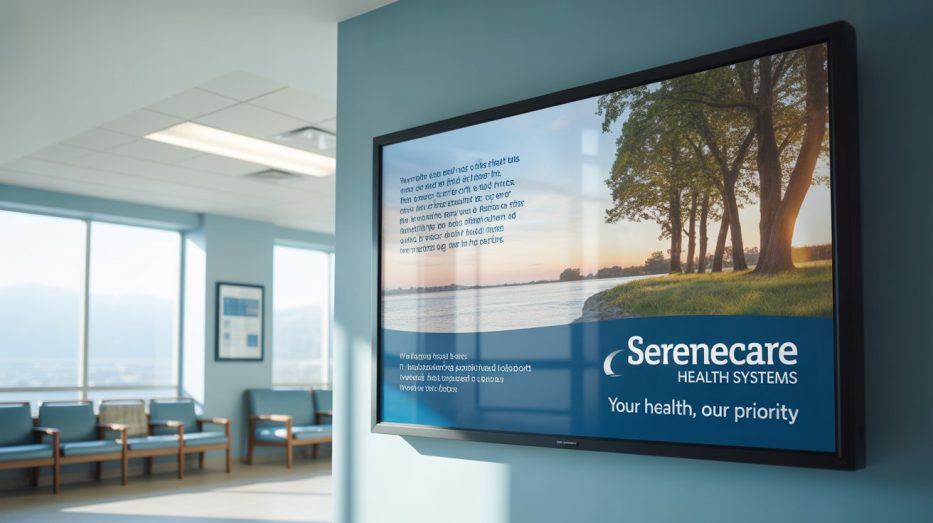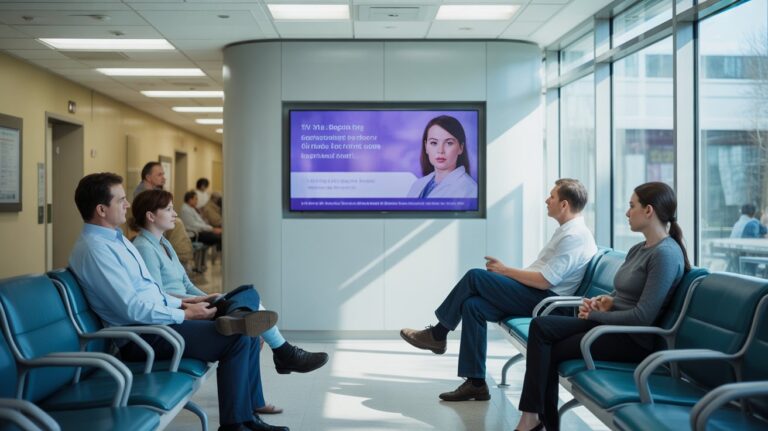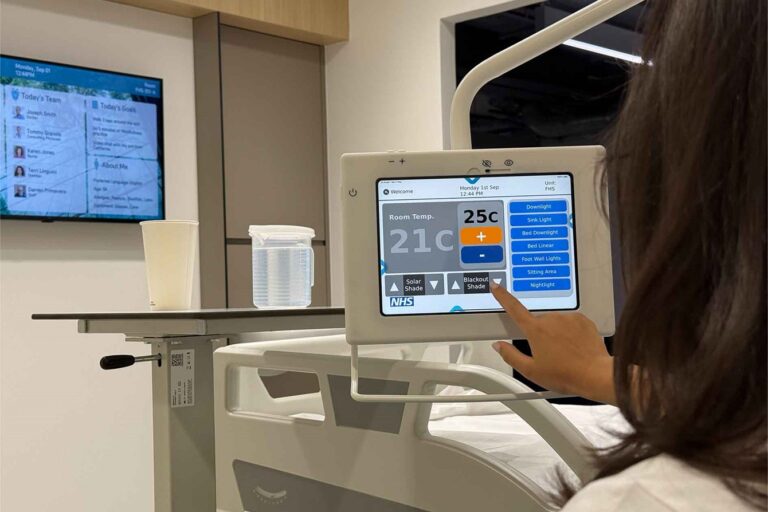
From nice-to-have to healthcare essential
Hospitals and clinics are busier and more complex than ever. Patients expect clear, timely information; staff need fewer interruptions; estates teams need consistent, accessible signage across sprawling sites.
This is where digital signage moves from “nice-to-have” to essential infrastructure. Below, we unpack the real-world benefits of digital signage for healthcare that measurably improve patient experience and operational flow.
Real-world applications of healthcare digital signage
In Emergency Departments, displays share estimated waiting times by stream, explain what happens next, and surface urgent safety messages to reduce uncertainty.
Outpatient areas use self check-in and digital wayfinding kiosks to guide patients from entrance to clinic, with live updates and multilingual options.
Along corridors and at lift lobbies, information walls provide orientation, highlight clinic changes, and run public-health campaigns at key decision points.
Inside clinics, screens reinforce prep steps (fasting, samples, forms), infection-prevention reminders, and “what to expect” messages to keep appointments on time.
In staff-only spaces, internal screens surface handover notes, bed-status summaries, and bite-size training—reducing email noise and saving time.
The common thread: dynamic, centrally managed content that’s consistent with local branding, legible at a distance, and accessible to everyone who uses your building.
1) Set expectations early in the Emergency Department
In Emergency Departments, uncertainty fuels anxiety and complaints. Digital signage helps by showing estimated waiting times by stream and clearly explaining what happens next—from triage to assessment to treatment.
The same screens can surface urgent safety messages (sepsis, chest pain, stroke symptoms) and signpost alternative pathways when appropriate, for example advising that minor injuries may be seen faster at a designated unit.
They also carry practical updates in real time: temporary closures, queue logic, interpreter availability, and any changes that affect patient flow.
2) Turn waiting rooms into education spaces
Waiting rooms are high-attention environments. Use screens to run timely vaccination, screening and prevention messages that nudge people toward the right care at the right time.
They’re also powerful for reducing patient uncertainty by explaining what to expect before an appointment or procedure in a clear, reassuring way.
You can surface clear self-care pathways and Pharmacy First options, helping patients choose appropriate services without needing to queue for basic advice.
And don’t overlook signposting to mental-health and community support; short, reassuring messages with easy next steps can make a real difference.
3) Support meaningful behaviour change (and track it)
In a hospital environment, digital signage can do more than inform — it can prompt timely actions that improve patient experience and support operational efficiency. For example, screens can be used to:
- Encourage patients to watch a short pre-op preparation video
- Prompt visitors and staff to use hand gel when entering and leaving wards
- Remind patients to check their discharge checklist before leaving hospital
- Direct outpatients to book follow-up appointments online
- Highlight opportunities to share feedback or volunteer
- Guide patients and visitors to scan a QR code for maps and directions inside the hospital
- Remind staff to complete mandatory training or check shift updates
Pairing these prompts with a QR code and a short, memorable URL makes it easy for people to act immediately. Reinforcing messages with trusted NHS or hospital branding also builds confidence and credibility.
4) Cut DNAs and late arrivals with better wayfinding
Confusing estates lead to late arrivals, missed slots, and stressed patients. Digital kiosks and lobby screens give step-by-step directions from entrance to clinic, with live updates if rooms move, corridors close, or lifts are out.
Clear, consistent direction, available in multiple languages and mirrored across kiosks and corridor screens, mean fewer “where do I go?” interruptions for reception and smoother clinics that run closer to time.
When linked to check-in, kiosks can surface a personalised route (including step-free options and an estimated walking time) and auto-reroute if a clinic relocates—removing one of the biggest causes of “I’m lost” delays.
5) Meet accessibility and brand standards by design
Digital signage should be inclusive by default. Start with large, high-contrast text, plain language and consistent layouts so messages are legible at a glance and easy to process.
Caption every video and offer BSL or visual alternatives where needed. Keep audio off by default in public areas, and ensure icons and colours aren’t the only way information is conveyed.
Reflect your local population with multilingual rotations and clear wayfinding cues. Set dwell times that allow slower readers to finish a message before it advances.
Protect privacy: never display patient-identifiable information on public screens. Use staff-only channels for operational or sensitive updates.
Match your physical estate. Align digital typography, colour and naming with NHS Identity so the experience feels consistent from door signage to corridor screens.
This isn’t just good practice—it’s required. The NHS Accessible Information Standard sets expectations for how information is provided to people with a disability or sensory loss, and well-designed screens help you meet those needs consistently.
6) Free up staff time without adding headcount
Front-of-house teams spend huge chunks of the day repeating directions, explaining waits and handing out leaflets. Well-placed screens take care of the routine questions—where to go, how long it might be, what to do next—so reception can focus on people who genuinely need human help.
Behind the scenes, staff-only screens surface policy updates, shift notes and training reminders at the point of need. They reduce inbox noise, speed up briefings and keep everyone aligned without pulling clinicians off the floor.
You can also display live operational cues—bed status summaries, clinic delays, portering or cleaning alerts—so teams have the same picture in real time and can act faster.
This isn’t about replacing people; it’s about removing low-value interruptions. The result is shorter queues, calmer desks and more time for safeguarding, complex access needs and escalations.

7) Make comms agile (and safer)
When guidance changes (such as infection-prevention updates, heat alerts, industrial action, etc.) centrally managed screens let you switch messaging across the clinic in minutes, not days. That’s faster, clearer and lower-risk than ad-hoc posters or verbal relays, and it removes the lag between “we emailed the ward” and “the message is visible where patients are.”
Use pre-approved templates and role-based publishing so the right people can push the right message to the right places. Emergency overrides ensure critical notices cut through immediately, while audit trails keep governance teams comfortable that the latest, correct version is on display.
The bottom line
The benefits of digital signage in healthcare are tangible: calmer waiting rooms, clearer expectations, fewer missed appointments, faster updates, and more time for human care where it matters.
Implemented well, digital signage becomes part of the clinical environment, with measurable impact on patient flow, staff workload and overall experience.
Explore deployment options, templates and integrations on our digital signage for hospitals page, or get in touch to discuss a focused pilot around ED communication or outpatient wayfinding.
Get in Touch with Airwave Healthcare
Want to experience the benefits of digital signage in healthcare first-hand?
Get in touch to discuss how screens can improve efficiency, enhance patient
experience, and support your hospital or clinic.
Frequently asked questions
How does digital signage in hospitals help reduce patient anxiety in waiting areas?
Patients often feel anxious when they don’t know how long they’ll be waiting or what will happen next. One of the biggest benefits of digital signage in healthcare is that it provides real-time wait-time updates, safety messages, and clear next steps. This reduces repeated “how long?” questions and helps create calmer, more informed waiting rooms. For more practical examples, see our blog: Digital Signage in Hospitals – A Practical Guide to Clearer Communication and Calmer Waiting Areas.
What role does digital signage for healthcare play in improving wayfinding and reducing missed appointments?
Confusing layouts and unclear signage lead to late arrivals, missed slots, and patient frustration. Digital signage for hospitals includes wayfinding kiosks and lobby screens that provide step-by-step, real-time directions. By helping patients get to the right place the first time, digital signage reduces DNAs (Did Not Attend appointments), cuts down staff interruptions, and improves clinic efficiency.
How can healthcare digital signage support NHS digital transformation and efficiency goals?
Hospital executives and IT teams are under pressure to deliver on digital-first strategies and reduce operational waste. A centrally managed digital signage platform aligns with NHS transformation goals by eliminating print costs, streamlining updates, and providing scalable communication across sites. The benefits of digital signage in healthcare also extend to freeing up staff time, reducing repetitive queries, and supporting sustainability agendas.
Can digital signage in hospitals support accessibility and inclusion standards?
Yes. Digital signage for healthcare is a powerful tool for meeting the NHS Accessible Information Standard. Screens can automatically rotate content in multiple languages, use high-contrast large text, provide captioned video, and integrate BSL or visual alternatives. This ensures information is accessible to patients with disabilities, language barriers, or sensory loss—improving equity in care delivery.
What evidence exists that digital signage delivers measurable benefits in healthcare settings?
There’s growing evidence supporting the benefits of digital signage in healthcare. Studies show it improves patient satisfaction, reduces complaints, increases uptake of public health initiatives, and cuts late arrivals through better wayfinding. NHS case studies also demonstrate measurable reductions in staff time spent answering repetitive questions. Beyond anecdotal benefits, digital signage for hospitals can provide data-driven insights through QR codes and engagement reporting—helping trusts evidence ROI and justify investment.
What types of hospital spaces benefit most from digital signage?
Digital signage for hospitals isn’t just for waiting rooms. It’s effective in Emergency Departments, outpatient check-in areas, corridors, lift lobbies, staff-only zones, and clinics. Each environment benefits differently — from calming patients to surfacing training updates for staff.
Does digital signage reduce pressure on front-line hospital staff?
Yes. Staff in receptions and wards often repeat the same directions or instructions dozens of times a day. By handling low-value interactions (directions, wait-time queries, prep instructions), digital signage frees staff to focus on safeguarding, escalations, and complex patient needs.

Dean Moody
Healthcare IT & Patient Engagement Specialist
Dean has worked in Healthcare IT across Europe since 1995. His early career focused on WiFi and RTLS (real-time location systems), and from 2013 onwards he embraced patient experience and engagement technologies. After leading his own IT support firm, he spent 20 years working in France before dedicating his recent career to designing NHS-centric patient engagement solutions that inform, educate, and entertain patients and staff.


